Mixed use buildings may combine office space with other functions such as warehouses, storage facilities, retail and/or manufacturing facilities. Some mixed use buildings or areas might be disclosure affected, depending on the amount of office space.
If the office space in the mixed use building is:
-
Less than 75% of the building or area by Net Lettable Area (or Gross Lettable Area if NLA is not available); or
-
Less than 1000 m2.
then the building is not disclosure affected.
A mixed use building is disclosure affected if:
-
at least 75% of the space in the building by Net Lettable Area (or Gross Lettable Area if NLA is not available) is for:
-
administrative
-
clerical
-
professional or similar information-based activities
-
any support facilities for those activities, such as kitchenettes and break out rooms
-
-
that space is at least 1000 m2.
This captures all activities that would typically take place in a commercial office space.
The above definition for ‘office’ is set out in the Building Energy Efficiency Disclosure Determination 2016 (the BEED Determination) under sections 5 and 6. The triggers for an office to be a disclosure affected building or area are set out in the Building Energy Efficiency Disclosure Act 2010 (the BEED Act).
The way in which the area of the office space is connected to the rest of the building will also determine whether the mixed-use building is disclosure affected.
Physically separate spaces in a mixed use building
If the building includes physically separate spaces within the building that:
-
shared access to the outside of the building
-
are linked internally to a space that provides shared access to outside the buildings
-
and can be grouped together to be leased or sub-leased.
then these physically separate spaces are also defined as a single ‘area of a building’ in accordance with the Determination.
Physically separate areas in a building that don’t have shared access to the outside are considered separate areas for the purpose of the CBD Program.
Multiple buildings in a mixed use complex
If the office space is fully contained in a different building to the non-office areas of a property, that office building is NOT a mixed use building. As an office building, it may be disclosure affected.
Office space internally connected to non-office space
Office buildings generally have a common primary entry point, such as a lobby or main entranceway.
If office space is internally connected to non-office space or these spaces share a common entry point, it is considered part of the same building. Together they comprise an ‘area of a building’ for the purposes of the Determination.
The criteria of the Determination must then be applied to this area of the building.
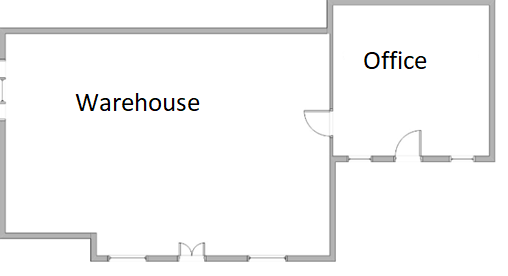
A building has office space internally connected to a warehouse area by a door. The 2 areas also share a common entry point.
-
The warehouse is 3,000 m2. It is connected by a door to an office.
-
The office space is 1,300 m2
As the office space is less than 75% of the building’s NLA, both the building and the office area are not disclosure affected.
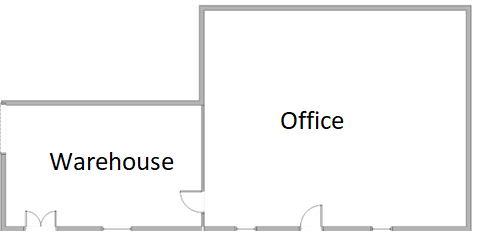
A building has office space internally connected to a warehouse area by a door. The 2 areas share a common entry point.
-
The warehouse is 500 m2. It is connected by a door to an office.
-
The office space is 1,600 m2
As the office space is greater than 75% of the building’s NLA and the total office area is at least 1,000 m2, the building is disclosure affected.
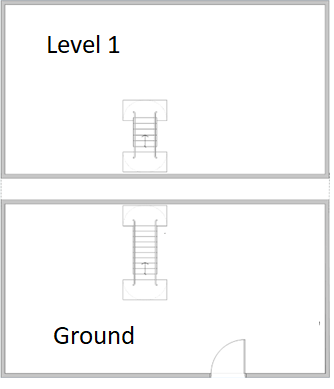
This is a 2-storey building:
-
Level 1 is 1,500 m2 and used as office space. It is connected to the Ground floor by an internal staircase.
-
The Ground floor is non-office space and has the only entrance point for both the Ground level and Level 1. It is 1,500 m2.
As the office space is less than 75% of the building’s NLA, both the building and the office area are not disclosure affected.
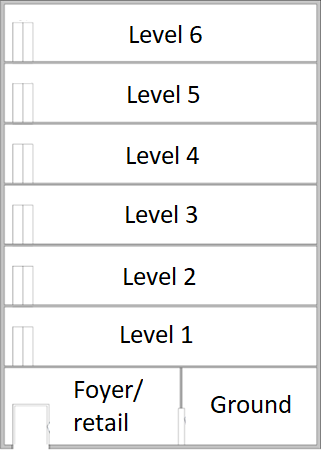
This is a 7-storey building:
-
The common entrance point to the building is a Foyer and Retail space. It connects internally via a door to a Ground level office. The Foyer is 1,000 m2 and the connected office space on the Ground floor is 800 m2.
-
An elevator in the Foyer provides access to 6 levels above.
-
Levels 1 and 2 are used for office space. Each is 1,800 m2.
-
Levels 3 through 6 are residential apartments. Each is 1,800 m2.
Added up, the office space on the Ground floor and Levels 1 and 2 is 4,400 m2 which is less than 75% of the building’s NLA. This means both the building and the office area are not disclosure affected.
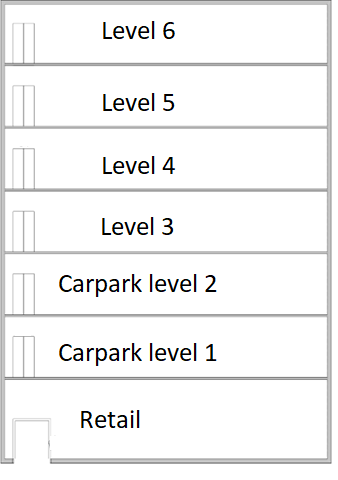
This is a 7-storey building:
-
The common entrance point to the building is via a Retail space on the ground level. It is 1,000 m2.
-
An elevator provides internal access to all 6 levels above.
-
Levels 1 and 2 are carparks. Each is 1,000 m2.
-
Levels 3 through 6 are office spaces and are 1,000 m2 each.
Carpark areas are not included in the calculation of a building’s NLA.
Added up, the office space is 4,000 m2 which is more than 75% of the total building’s NLA. This means the building is disclosure affected.
Office space not internally connected to non-office space
If the office space isn’t internally connected to the non-office space and has a separate entrance, the spaces are not considered to comprise an ‘area of a building’. The office space is regarded as a separate area for the purposes of the Determination and the CBD Program.
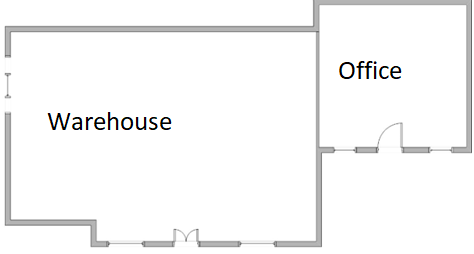
This building has office space attached to a warehouse:
-
The Warehouse is 3,000 m2. It shares a wall with an office space, but there is no internal door connecting them. It has its own entrance.
-
The Office space is 1,300 m2. It has its own entrance.
The office space is assessed separately to the non-office space. As the office space is larger than 1,000 m2 this area is disclosure affected.
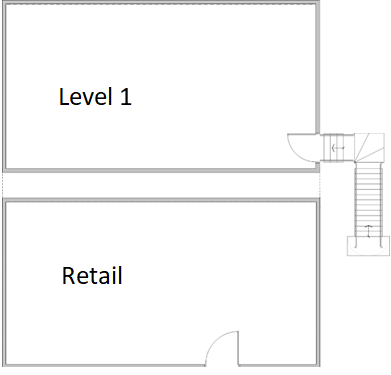
A 2-storey building has a retail space on the ground level and office space on Level 1:
-
Level 1 is 1,500 m2 and used for office space. It can only be accessed by an external staircase.
-
The retail space on the ground floor is 1,500 m2 and has neither internal nor common access to Level 1.
The office space is assessed separately to the non-office space. As the office space is larger than 1,000 m2, the Level 1 office area is disclosure affected.
Multiple buildings on one site
When there are multiple buildings on one site or address, each building is treated individually unless they are interconnected.

There are 4 buildings on the one site, all used as office space. None of the buildings are connected and all have their own entrances. This means they are assessed individually.
-
Building 1 is 700 m2
-
Building 2 is 400 m2
-
Building 3 is 800 m2
-
Building 4 is 1,150 m2
Building 4 is the only office space greater than 1,000 m2 which means it is the only disclosure affected building.

There are 4 buildings on one site, all used as office space:
-
Building 1 is 700 m2 and connected by an internal walkway to Building 2.
-
Building 2 is 400 m2.
-
Building 3 is 1,150 m2 and unconnected to any other building
-
Building 4 is 800 m2 and unconnected to any other building.
Because Buildings 1 and 2 are interconnected by an internal walkway, they are assessed as one building—a total of 1,100 m2. As this is over 1,000 m2 it is a disclosure affected building.
Building 3 is over 1,000 m2 so it is also disclosure affected.
Building 4 is less than 1,000 m2 so it is not disclosure affected.
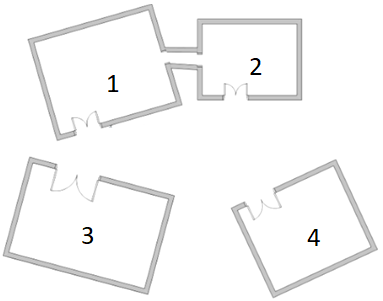
There are 4 buildings on the one site:
-
Building 1 is used for retail purposes and is 2,000 m2. It is connected by an internal walkway to Building 2.
-
Building 2 is used for office space and is 1,050 m2.
-
Building 3 is used for office space and is 1,150 m2.
-
Building 4 is used for office space and is 800 m2.
Because Buildings 1 and 2 are interconnected by an internal walkway, they are assessed as one building. As the office space is less than 75% of the building’s NLA, this building is not disclosure affected.
Building 3 is over 1,000 m2 so it is disclosure affected.
Building 4 is less than 1,000 m2 so it is not disclosure affected.
Read more
-
Understand the definition of an ‘office’ for the purposes of the CBD Program
-
Read about disclosure affected buildings
-
Check whether an exemption may apply.